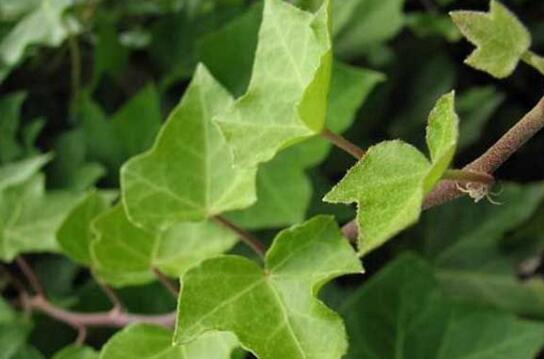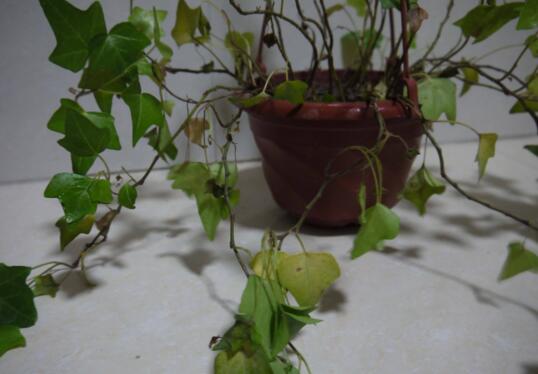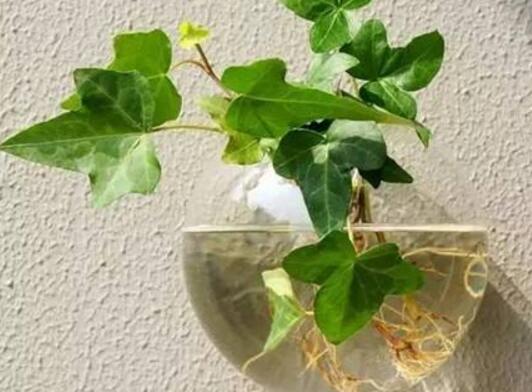What if the ivy leaves are dry? there are five ways to improve the leaf dryness.
Under normal circumstances, the leaves of ivy are dark green and glossy, but some flower friends find that their ivy leaves are dry, which is very distressing, so what if the ivy leaves dry up? Find out the main reason in order to find the right way.
What if the ivy leaves are dry?

We know that if we want to raise ivy well, we must first understand the culture method of ivy, and the method involves many aspects, among which watering, light, fertilization, soil, diseases and insect pests will have an important impact on growth. they are also the main causes of leaf dryness. What if ivy leaves dry up? The specific methods are as follows.
1. Too little watering
When planting ivy, if there is too little watering, the leaves lack of water, its own metabolism will be affected, when the growth is poor, the leaves will dry up, so do not water the ivy for a long time.
What to do: replenish water in time to keep the soil slightly moist. The specific method can refer to the detailed description of how ivy is watered. But it should be noted that each watering should not be too much, based on the principle that there is no stagnant water in the basin.
2. Excessive illumination
Ivy can grow in full light, it can accept the direct light of the sun, but if you move the ivy which has been in the dark for a long time to the sun, it will burn because the light is suddenly too strong, and the leaves will wither and fall.
What to do: what about the drying up of ivy leaves caused by changes in light? The answer is that when you move it outside, shade it first, keep the sunshine at about 50%, avoid direct sunlight, and gradually recover after it adapts to the new light environment.
3. Fertilization is not enough.
Only when the ivy is formed, fertilization can be appropriately reduced, and during the growing period, thin liquid fertilizer should be applied every 15 days. If there is too little fertilizer, not only will the growth be slow, but the leaves will also become dim and dull. Long-term lack of fertilizer may lead to leaf drying.
What to do: appropriate topdressing, mainly nitrogen fertilizer, appropriate increase of phosphorus and potassium fertilizer, fertilization with thin fertilizer and water, should not be too high concentration, once every 15 days, generally 2-3 times can make the leaves turn thick green again.
4. Soil consolidation
Soil hardening will not only affect the absorption of water and fertilizer by ivy, but also affect the respiration of roots, thus indirectly affecting the growth of plants. Without necessary nutrients, the leaves will gradually fade, and it is inevitable that the leaves will eventually dry up. What if the ivy leaves dry up caused by this reason? The method is as follows.
What to do: turn the basin and change the soil as soon as possible to ensure the air permeability of the soil, which can not only avoid the problem of dry leaves, but also conducive to the growth of ivy. In the process of turning the basin and changing soil, an appropriate amount of organic fertilizer and water can be added to improve the content of nutrients in the soil.
5. Diseases and insect pests
Many pests feed on the leaves or sap of ivy, such as red spiders, aphids, etc. If these pests appear on the ivy, the sap of the leaves will be sucked, resulting in nutrient deficiency, thinness and dryness of the leaves.
What to do: when diseases and insect pests are found, they should be cleared in time, if a large number of pests appear, drugs should be used to control them, and the diseased leaves should be removed in time. After that, we need to pay attention to the cleanliness and cleanliness of the environment to avoid the recurrence of insect pests.
What to do about the yellowing of ivy leaves? the causes and solutions of yellowing of ivy leaves
When many people are raising ivy, they will encounter when the ivy leaves turn yellow, what if the ivy leaves turn yellow? The following is to tell you the causes and solutions of the yellowing of ivy leaves.
1. The first situation is the yellowing of old leaves, which is very common, which is a very normal metabolism. We don't have to care too much, as long as we do a good job of cleaning up in time.
2. No matter which variety of ivy, the basin soil should be kept moist in winter, not too dry or too wet, pay attention to the humidity of indoor air, too low is easy to cause leaf edge withered and yellow, so we should often pay attention to indoor air humidity in winter, if the humidity is not enough, timely measures should be taken to replenish moisture.
3, the influence of light: avoid direct sunlight in summer, if direct sunlight, it is easy to cause leaf necrosis, no shade in winter, the light can be appropriately stronger.
4, the influence of temperature: ivy has the habit of being cold, but ivy is especially afraid of frost. It can grow without heating indoors. In addition, poor growth in high temperature in summer, should be placed in a cool and ventilated place.
5, the influence of water: in the growing period of ivy, we must keep the basin soil moist, but avoid stagnant water in the basin; in winter, we can reduce the amount of water and avoid the phenomenon that the basin soil is too dry.
6. the influence of humidity: in the high temperature and dry season or indoor, you should often spray water to the leaf surface and around the plant, and often clean the leaf surface.
7, there are diseases and insect pests: when this happens, we should be able to observe with the naked eye whether it is a bug, or if there is any difference from before, we can use low concentration pesticide spray to solve this problem.
8. Lack of iron: the lack of iron begins to turn yellow from the tender leaves. If this happens, you can put a certain amount of iron shavings into the soil, which can solve this problem very well.
9. If the original environment is different from the current environment, it will cause the plant to temporarily unable to adapt to the leaves and turn yellow.
What if the leaves of ivy are dry?
The leaves of ivy are dry-- watering is improper
Improper watering is a common cause of drying up ivy leaves.
When raising ivy, watering should be kept dry and watered, and be careful not to be wet for a long time. Otherwise, it is easy to be waterlogged to death and the leaves are easy to dry up.
Pay attention to watering
Usually water ivy, need to water after the soil is dry, if the water is not enough, whether to pour a lot of water, can be used to spray water, can prevent the leaves from drying.
Ivy leaves are dry-dry and lack of light
In fact, the effect of light on the growth of ivy is also very important, it likes light, but afraid of exposure, culture is generally kept semi-overcast, at least 3 hours of light every day.
If the light is not enough, the plant is easy to grow slender, yellowing, or even dry up.
Keep the light.
When raising ivy, is it important to choose a suitable location? put it in a place with light but no exposure, and keep it ventilated.
The ivy leaves are dry-the soil is too dry
When raising ivy, you need to keep it moist, and the moisture of the soil is also very important, not too dry, it's easy to turn yellow and dry up.
Be careful to keep watering.
Ivy leaves withered-- red spider
If your ivy is affected by the red spider, the leaves will turn yellow and dry, and even lose the leaves.
We should pay attention to the prevention of red spiders, strengthen ventilation, and timely find pests and kill them.
- Prev

How to water ivy, how often is it watered / the growth rate is combined with climate
It is well known that ivy is a plant that likes a wet environment, so when planting it, you need to water the soil to keep the soil moist, and spray water on the leaves when the humidity is low, so how do you water the ivy? How often is the ivy watered? Next, the editor will tell you the answer.
- Next

Can Ivy be cultured in water? the method of water culture of ivy / water planting of branches is the most practical.
As a common indoor foliage plant, ivy has always been loved, and in all the breeding methods, hydroponic culture can maximize the efficacy and ornamental value of ivy, but can ivy be hydroponically cultivated? The answer is yes. Today we will introduce the hydroponic culture method of ivy.
Related
- Fuxing push coffee new agricultural production and marketing class: lack of small-scale processing plants
- Jujube rice field leisure farm deep ploughing Yilan for five years to create a space for organic food and play
- Nongyu Farm-A trial of organic papaya for brave women with advanced technology
- Four points for attention in the prevention and control of diseases and insect pests of edible fungi
- How to add nutrient solution to Edible Fungi
- Is there any good way to control edible fungus mites?
- Open Inoculation Technology of Edible Fungi
- Is there any clever way to use fertilizer for edible fungus in winter?
- What agents are used to kill the pathogens of edible fungi in the mushroom shed?
- Rapid drying of Edible Fungi

